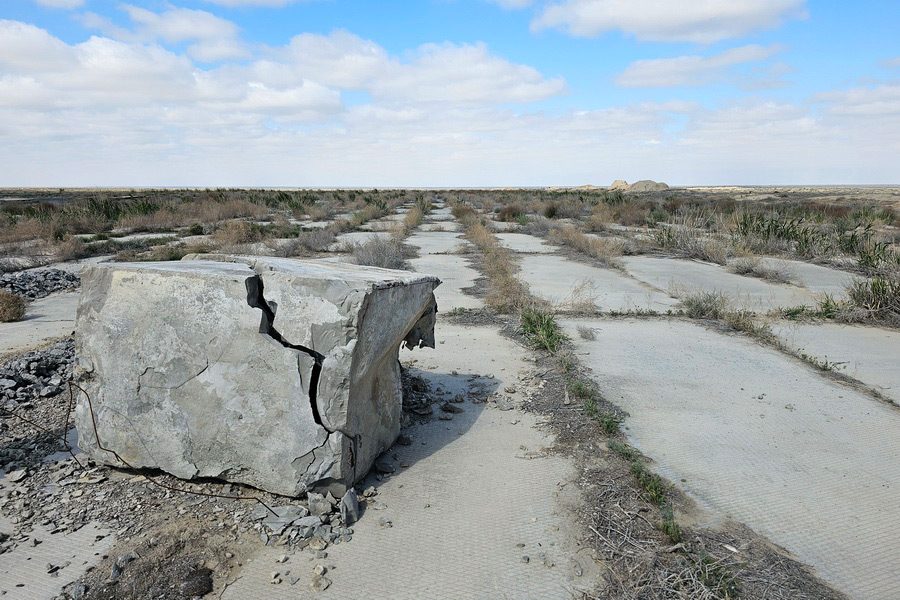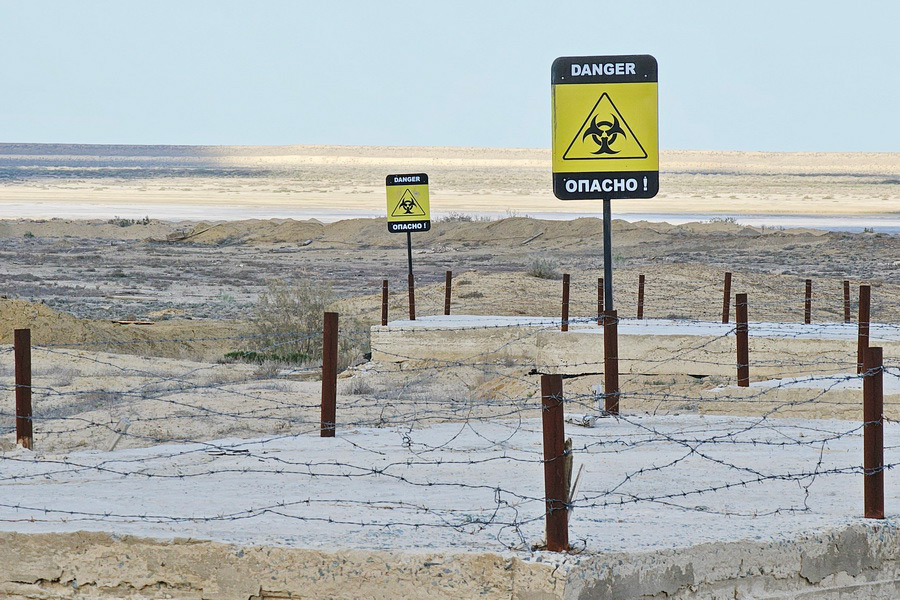Vozrozhdeniya Island, Aral Sea
 Aralsk-7 city on Vozrozhdeniya Island. U.S. military satellite image, late 1960s
Aralsk-7 city on Vozrozhdeniya Island. U.S. military satellite image, late 1960s
Our planet is filled with dangerous and mysterious places, including secret military bases and ghost towns. One such place was once found on Vozrozhdeniya (Rebirth) Island in the middle of the Aral Sea, dedicated solely to the development and testing of biological weapons. Located far from populated areas, in a remote and inaccessible location, the military testing range known as "Barkhan" was constructed. And not far from it, the town of Aralsk-7 was built to house scientists and military personnel.
Fortunately, the testing ground has been closed for a long time, and a few years ago, it was demolished along with the town. Researchers of unusual places continue to be intrigued by its history and mysteries. Here, we have compiled interesting facts and details about the Barkhan range and the town of Aralsk-7.
In 1848, A. Butakov discovered Vozrozhdeniya Island while exploring the Aral Sea. The island was initially named in honor of Tsar Nicholas I and became known as Vozrozhdeniya Island following the establishment of the USSR. It had no sources of fresh water but supported populations of saiga antelopes and waterfowl, making it a safe haven for these animals. In the early 20th century, a small settlement emerged on the island, serving as a temporary stopover for fishermen, and a small fish processing plant was also operating there. Later, from 1924 to 1926, the island was used to exile kulaks (wealthy peasants).
In 1933, the Red Army’s Military Scientific-Medical Institute was established in Russia, headed by I.M. Velikanov. The institute was tasked with developing vaccines for military purposes and researching dangerous diseases and strains. Conducting such projects in populated areas was deemed too risky, and a secure testing ground was necessary. Gorodomlya Island on Lake Seliger was chosen as the location for the institute, while Vozrozhdeniya Island in the Aral Sea was ideal for field research. Vozrozhdeniya Island, being 150 km away from the nearest towns of Muynak and Aralsk, virtually eliminated any risk of unintended visitors. And its high summer temperatures, often exceeding 40 degrees Celsius, helped neutralize many viruses and bacteria.
The island hosted its first scientific expedition in 1936, aimed at assessing its suitability for a testing range. The expedition was led by I.M. Velikanov himself, who is now considered the father of the USSR's bacteriological program. The following year, initial tests were conducted. Researchers evaluated the impact of various infections. The testing of agents for tularemia, cholera, and plague as potential biological weapons and vaccines against these diseases was carried out. In 1938, Velikanov was arrested and executed, which significantly set back the scientific research.
The Great Patriotic War in 1941 led to the relocation of many Soviet enterprises, including laboratories and institutes, to the east of the country. In 1942, Vozrozhdeniya Island became yet another testing ground for biological weapons, and scientists were temporarily stationed there.
 On the left is the airfield, on the right is Aralsk-7, and below is the laboratory
On the left is the airfield, on the right is Aralsk-7, and below is the laboratory
The full-scale launch of the military-scientific complex on Vozrozhdeniya Island only occurred in 1948. All fishermen and other local residents were evacuated, and the fish processing plant was shut down. A military unit with barracks to accommodate 800 service members was constructed on the island, along with a small town for scientists and their families. The town was named Aralsk-7 (also known as Kantubek). It featured 15 three-story buildings, a club for cultural events, a cafeteria, shops, a stadium, a parade ground, and its own power station.
In 1949, an airfield with four runways was built 3 km west of the town. The runways were designed like a wind rose, as the island always experienced strong and variable winds. The airfield was named "Barkhan." Around the same time, 3 km southwest of the town, a laboratory complex was constructed where scientists commuted daily. The testing range for field trials was established 15 km south, at the very edge of the island.
The island became one of the most secretive sites in the USSR. The area was strictly forbidden, and fishermen who happened to be nearby during severe storms were allowed to wait out the weather in one of the bays without going ashore. Although the island was part of the Uzbek SSR, its provisions were managed from the Kazakh SSR side. 5 km northwest of the Kazakh port of Aralsk, a closed military town known as Aralsk-5 (also referred to as Aralsk-6 or Aralsk-8) was built. From that point on, the logistical support for the island was handled with the delivery of fresh water, fuel, and food.
 Ruins of the airfield in Aralsk-7
Ruins of the airfield in Aralsk-7
Life on the island resembled that of a typical border garrison. The military secured the area, while in town, life went on normally. Children attended kindergarten and school, parents worked at the laboratory, and in the evenings, residents gathered at the club where movies were shown and families held picnics by the shore on weekends. The only drawbacks were the hot desert climate and the town's isolation.
Despite the ordinary nature of life in the town and on the island, it was one of the most terrifying and dangerous places in the USSR. The laboratory complex, officially known as PNIL-52 (Field Scientific Research Laboratory No. 52), stored the deadliest viruses, infections, and their man-made modifications. Horses, sheep, dogs, rats, and even monkeys were used for testing. It is well known that shipments of chimpanzees and other primates were imported from Africa. Unfortunately, all of these animals were victims of biological weapons testing.
The actual tests took place 15 km south of the laboratory. Animals were tied up, and strains of viruses and infections were dispersed via airplanes or bombs. Scientists observed the rate of spread and development of diseases and studied the consequences of their grim experiments.
Over 50 years, diseases such as anthrax, plague, smallpox, tularemia, brucellosis, and others were tested on Vozrozhdeniya Island. It is impossible to determine the exact list of diseases and strains. Nevertheless, it is acknowledged that this range was a central site for field-testing, containing samples of biological weapons. They were sent here from all over the USSR, from secret cities like Stepnogorsk, Kirov-200, Sverdlovsk-19, Omutninsk, Zagorsk-6, and others.
From 1960, the water level in the Aral Sea began to fall, intensifying yearly. The area of Vozrozhdeniya Island started to expand when the shoreline moved away from the town. Over time, the airfield became the sole method of communication with the island, as barges were not able to deliver water and provisions. Over 30 years, the area of Vozrozhdeniya Island increased tenfold! In 1960, it was 216 square kilometers, and by 1990, it had expanded to over 2000 kilometers. By the early 21st century, the island had become a peninsula, and by 2009, it had completely merged with the mainland.
 Warnings regarding burial sites for biological weapons
Warnings regarding burial sites for biological weapons
In 1988, the "Barkhan" range was converted into a burial site for biological weapons. Tons of biological weapons named Anthrax 836, based on anthrax, were buried on Vozrozhdeniya Island. Additionally, numerous animal burials were made, victims of the experiments.
In 1991, Uzbekistan gained independence, and the USSR collapsed. Despite this, the town and military unit continued to exist under the jurisdiction of Russia. Fortunately, in the new realities, the development of biological weapons became outdated, and Aralsk-7 lost its significance. In November 1991, the laboratory was closed, and by early 1992, all residents were evacuated. Aralsk-7 became a ghost town.
In 1995, at the invitation of the authorities of Uzbekistan and Kazakhstan, American scientists visited Aralsk-7 and conducted studies of the dangerous substances buried there. They discovered that some spores and bacteria had survived despite the heat and disinfection of the burial sites. Similar expeditions were also carried out in 1997, 1999, and 2002. American bacteriologists evaluated the efficacy of their vaccines against anthrax bioagents and other diseases. In 2018, journalists from Tashkent produced the last photo report about Aralsk-7.
 The last surviving building in Aralsk-7 - the building at the northern pier
The last surviving building in Aralsk-7 - the building at the northern pier
By 2021, the town of Aralsk-7 and the laboratory complex 3 km from it had been completely demolished by the authorities of Uzbekistan. Today, only traces of foundations and the cruciform strips of the "Barkhan" airfield remain. The once top-secret city has become a part of history, but over the years since its declassification, it has been surrounded by legends and even featured in video games. Developers of games like Call of Duty and World of Tanks have created locations inspired by this mysterious place in the heart of the Aral Sea.
A sensible person would not want to visit such a place voluntarily. Despite all the safety measures taken, it cannot be guaranteed that some virus or bacteria won't escape from the burial sites on Vozrozhdeniya Island. Perhaps it will be safe here in decades, but is it worth testing fate? It's better not to risk it and never approach this place.



